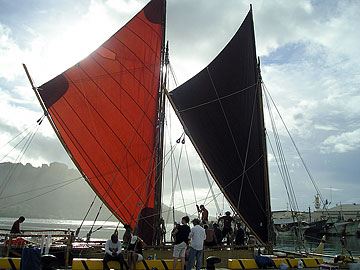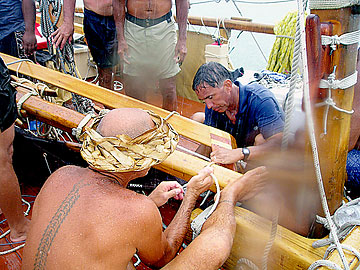
GARY T. KUBOTA / GKUBOTA@STARBULLETIN.COM
The crew of the double-hulled canoe Hokule'a and friends refitted and raised the traditional crab-claw sails in Pohnpei for its voyage to Satawal island, the home of renowned Pacific navigator Mau Piailug. CLICK FOR LARGE
|
|
Hokule'a dons traditional crab-claw sail
KOLONIA HARBOR, Pohnpei » With a few tugs on several ropes, crew members of the Hokule'a and friends raised the traditional Hawaiian crab-claw sails, after a day of work refitting the masts and attaching booms.
Hokule'a navigator Nainoa Thompson said he decided to return to the traditional Hawaiian design because it was the way the double-hulled canoe looked during the historic Hawaii-Tahiti voyage in 1976 with Micronesian navigator Mau Piailug.

FOLLOW ALONG» Follow the voyage of Hokule'a at the Polynesian Voyaging Society web site at: www.pvs.hawaii.org
» Star-Bulletin reporter Gary Kubota is sailing with Hokule'a and will respond to selected reader questions from the canoe via satellite hookup, when possible. Email questions to hokulea@starbulletin.com
|
The Hokule'a is escorting the double-hulled canoe Alingano Maisu, which is being delivered as a gift to Mau at his home island of Satawal in gratitude for him teaching Pacific way-finding navigation to native Hawaiians.
"Those sails define who we are as Polynesian sailors. It's in respect and honor for Mau that we sail here in the traditional design," Thompson said. "We're also sailing to honor Micronesians, the world's greatest sailors."
The two voyaging canoes are scheduled to leave tomorrow from Pohnpei on the next leg of their journey, a 380-mile, four-day sail to Chuuk.
Thompson said the crab-claw sails were switched in 1999 to Western-type sails for the trip to Rapa Nui.
He said during the early 2000s, the Hokule'a used Western-type sails without booms because they posed less of a potential hazard, and the canoe conducted many educational tours statewide involving youths.
Some replacements on the crew to Satawal are knowledgeable about how to operate with crab-claw sails, including members of the 1976 Hawaii-Tahiti voyage such as Billy Richards, Abraham "Snake" Ah Hee, John Kruse and Thompson.
Kimo Hugo, the 1976 Hokule'a crew chief, will be sailing on the Alingano Maisu.
Richards said sailing with the crab-claw sails keeps crew members busy.

GARY T. KUBOTA / GKUBOTA@STARBULLETIN.COM
Hokule'a navigator Nainoa Thompson, inset, worked on the rigging with crew member Tim Gilliom yesterday in Kolonia Harbor in Pohnpei, despite heavy rain. CLICK FOR LARGE
|
|
"It does require a lot more work," he said, "but if you want to know what our ancestors did, they did it this way."
The Hokule'a and Alingano Maisu plan to sail about 360 miles to Chuuk, before going to Satawal to honor Mau, then on to Ulithi and Yap.
Voyagers planned to sail to Palau after Yap but are now considering going directly to Okinawa to arrive before the end of March and prior to typhoon season.
Crews including the escort vessel Kama Hele have been cleaning and re-provisioning the vessels while in Pohnpei.
Besides taking out the old provisions to clean the canoe holds, the crews have been unloading and restocking food into plastic containers marked for each day at sea.
Some crew members have been visiting schools to conduct education seminars about voyaging canoes.
A busload of crew members went on a tour of the historic ruins of Nan Madol, the home of a Micronesian empire that employed canals and bridges to connect more than 90 islets.
Crews have also attended a number of social functions, some sponsored by traditional chiefs and the communities of Yap.
Monday night, the crews attended a dinner party at the U.S. Embassy in Pohnpei organized by U.S. Ambassador Suzanne Hale.
The sail through Micronesia is the first for the Hokule'a and second for several crew members with the Alingano Maisu, a number of whom came in 1999 with the Big Island double-hulled canoe Makali'i.
Alingano Maisu navigator Chadd Paishon said in the last eight years since he had been to Pohnpei, the appearance of the island had changed significantly.
Where once there were only two tuna boats at Kolonia Harbor, there is now a fleet of boats with fishing nets that indiscriminately catch all the sea life that they surround.
"It's insane. How could this be happening?" Paishon asked.

